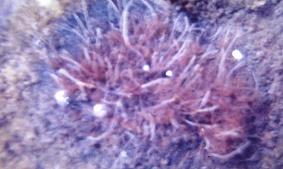Sludge Worm on:
[Wikipedia]
[Google]
[Amazon]
 ''Tubifex tubifex'', also called the sludge worm, sewage worm, or simply tubifex worm, is a
''Tubifex tubifex'', also called the sludge worm, sewage worm, or simply tubifex worm, is a
 ''Tubifex tubifex'', also called the sludge worm, sewage worm, or simply tubifex worm, is a
''Tubifex tubifex'', also called the sludge worm, sewage worm, or simply tubifex worm, is a species
A species () is often defined as the largest group of organisms in which any two individuals of the appropriate sexes or mating types can produce fertile offspring, typically by sexual reproduction. It is the basic unit of Taxonomy (biology), ...
of tubificid segmented worm which inhabits the sediments of lake
A lake is often a naturally occurring, relatively large and fixed body of water on or near the Earth's surface. It is localized in a basin or interconnected basins surrounded by dry land. Lakes lie completely on land and are separate from ...
s and river
A river is a natural stream of fresh water that flows on land or inside Subterranean river, caves towards another body of water at a lower elevation, such as an ocean, lake, or another river. A river may run dry before reaching the end of ...
s on several continents. '' Tubifex'' likely includes several species, but distinguishing between them is difficult because the reproductive organ
A sex organ, also known as a reproductive organ, is a part of an organism that is involved in sexual reproduction. Sex organs constitute the primary sex characteristics of an organism. Sex organs are responsible for producing and transporting ...
s, commonly used in species identification, are resorbed after mating, and because the external characteristics of the worm vary with changes in salinity
Salinity () is the saltiness or amount of salt (chemistry), salt dissolved in a body of water, called saline water (see also soil salinity). It is usually measured in g/L or g/kg (grams of salt per liter/kilogram of water; the latter is dimensio ...
. These worms ingest sediments, selectively digest bacteria
Bacteria (; : bacterium) are ubiquitous, mostly free-living organisms often consisting of one Cell (biology), biological cell. They constitute a large domain (biology), domain of Prokaryote, prokaryotic microorganisms. Typically a few micr ...
, and absorb molecules
A molecule is a group of two or more atoms that are held together by attractive forces known as chemical bonds; depending on context, the term may or may not include ions that satisfy this criterion. In quantum physics, organic chemistry ...
through their body walls.
Micro-plastic ingestion by ''Tubifex'' worms acts as a significant risk for trophic transfer and biomagnification of microplastics
Microplastics are "synthetic solid particles or polymeric matrices, with regular or irregular shape and with size ranging from 1 μm to 5 mm, of either primary or secondary manufacturing origin, which are insoluble in water." Microplastics a ...
up the aquatic food chain. The worms can survive with little oxygen
Oxygen is a chemical element; it has chemical symbol, symbol O and atomic number 8. It is a member of the chalcogen group (periodic table), group in the periodic table, a highly reactivity (chemistry), reactive nonmetal (chemistry), non ...
by waving hemoglobin
Hemoglobin (haemoglobin, Hb or Hgb) is a protein containing iron that facilitates the transportation of oxygen in red blood cells. Almost all vertebrates contain hemoglobin, with the sole exception of the fish family Channichthyidae. Hemoglobin ...
-rich tail ends to exploit all available oxygen, and can exchange carbon dioxide and oxygen through their thin skins, in a manner similar to frogs. They can also survive in areas heavily polluted with organic matter that almost no other species can endure. By forming a protective cyst and lowering its metabolic rate, ''T. tubifex'' can survive drought and food shortage. Encystment may also function in the dispersal of the worm.
They usually inhabit the bottom sediments of lake
A lake is often a naturally occurring, relatively large and fixed body of water on or near the Earth's surface. It is localized in a basin or interconnected basins surrounded by dry land. Lakes lie completely on land and are separate from ...
s, river
A river is a natural stream of fresh water that flows on land or inside Subterranean river, caves towards another body of water at a lower elevation, such as an ocean, lake, or another river. A river may run dry before reaching the end of ...
s, and occasionally sewer lines and outlets.
References
{{DEFAULTSORT:Tubifex tubifex Tubificina Animals described in 1774 Taxa named by Otto Friedrich Müller